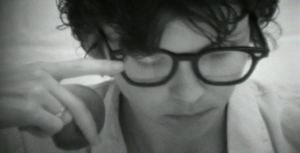
Beginnings: an interview with Lisa Steele (2008)
Mike: You were born in Kansas City in 1947. It was the year that Jackie Robinson became the first black player to play in major league baseball. Can you talk a little about that place and your family?
Lisa: Kansas City’s midwest tagline is “the heart of America.” Some of my upbringing happened with my grandparents. My grandfather was from the Ozarks and was a bit of a hillbilly, he was quite smart, though shall we say, untrained. He had many jobs and worked until he was 85. When I lived with him he looked after horses at the Longview Farm and he also tended their greenhouses. Then he became the water treatment officer for the Unity School of Christianity. It was run by a family of vegetarians who had a television program called The Daily Word. They had a beautiful compound with Spanish-style architecture and a fresh water lake that was the compound’s source of water, and he treated it with chlorine to make it potable.
Mike: Why were your grandparents looking after you?
Lisa: My parents were sales people, and not doing very well I suspect, so they moved in with my mom’s parents. Then they went on the road selling coats and suits. My father was the salesman, my mother was the model. They had a fairly large territory and would be away for many weeks. After they separated, my mother did secretarial work after they separated, and then she became a sales agent for Hollister Hospital Supplies which was one of the few companies hiring women to go on the road. The owner, J.D. Hollister, said that many hospital administrators were women – particularly nuns working in Catholic hospitals – and they were more comfortable working with other women. As a travelling saleswoman, mother always had a fabulous new car each year and traveled the entire mid-west. I accompanied her in the summers to Topeka, Wichita, Dodge City, Nebraska, Iowa, South Dakota. The summers were fun.
Mike: Did you have inklings of what art might be?
Lisa: I think I was always drawn to art. I was given art supplies and drew a lot, but I didn’t have any aspiration to go to art school. I didn’t know there was such a thing to be quite honest. I went to the University of Missouri in Kansas City to study English literature and drama, mostly 18th century literature and earlier.
Mike: Did you imagine you would teach?
Lisa: I was a hippie then so I didn’t think of myself as a teacher. That wasn’t what I was going after. I went to school on a Lyndon Johnson Poverty Program scholarship because I was considered to be an orphan even though my father was alive. I went to school free of charge and was given a little bit of money to live on. It was a program for disadvantaged youth that really worked, particularly for minority kids. In this state university there were other two non-people of colour. It was interesting group to be around. In my second year of college, I started making regular 8 films. My professors let me do that rather than write papers sometimes. So I bought my own film camera and that’s how I started. When I came to Canada I sold my film camera, but I was unhappy not having anything to work with. So I got a still camera.
Mike: After your parents separated, your father didn’t speak to you much anymore?
Lisa: No, we talked, he just didn’t… things were a bit rough financially. Life goes on, my brother was five years older and sometimes he would live with my mother, while I would live with my grandparents. There was a certain amount of chaos, you learned to roll with the changes. Today I find myself as an adult living in the same house for thirty years, omigosh, even after five years I was astonished.
Mike: Were you involved with Students for a Democratic Society, the anti-war, pro-civil rights, New Left movement?
Lisa: Yes. By the time we were planning to move up to Canada we were living in a hippie commune of three couples. Half were art students and half were liberal arts students going to university and part of SDS. We were very politically active. We dragged the artists along. We were part of a Marxist group at that point, and then a Maoist collective. We did a lot of work around factories that were producing components used in arms. I was particularly involved with the Fort Hood Three who were Hispanic soldiers who had refused to go to Vietnam. They were jailed in Leavenworth, a federal penitentiary, and we organized rallies. That was my last political activity before I left the States. We marched every Saturday. From 1965 onwards most American cities had a weekly anti-war march of some kind, small or large.
We decided that we would go to the SDS Annual Meeting in Madison, Wisconsin. It was the summer of 1967. We drove in a battered automobile from Kansas City, so it took a couple of days to get there. By the time we arrived, we had missed a lot of the plenary. Apparently the women had just split from SDS because they were not going to make the coffee anymore. They were just screaming. My friend Janice Spellerberg and I thought, “OK, this is so cool!” We got right into this newfound sisterhood and did as much reading as we could, especially Black Panther stuff, Shulamith Firestone, and Simone de Beauvoir’s The Second Sex. I didn’t take any of that at school. Feminism wasn’t taught at that point, so you had to learn about it yourself. I look back at that particular summer as a very interesting time because it really did polarize my thoughts. From then on, I was involved in women’s groups.
Mike: Did you have any plans when you finished university?
Lisa: I didn’t finish university. I left before graduating because I married a guy who was a draft dodger. He was a year older and received his draft notice immediately after graduation. When I came up to Canada I thought I would finish my degree, and a few years later I applied and was accepted to the University of Toronto, but I couldn’t really afford to go. I was underemployed for quite a long time when I first got to Canada, we all were.
By 1970 or 1971 I had a still camera and a rudimentary basement dark room. Then I got involved with a lot of other women in the Baldwin Street Women’s Photography Co-op. We held the first juried open call for women’s photography in Canada. We received submissions from all over the country, including photographers who are very well known now, but just starting out at that point. We got the whole range of submissions: nature photography, portrait photography, activist photography, abstract photography, and so on. I was most interested in women’s domestic lives: the way in which one lived every day was central. I was very committed to the idea that the actual stuff of your life was the stuff of your art. That was something I advocated for on behalf of the works we looked at. I remember there were a couple of us who were of the mind that, “Yes, it’s great that someone has gone down and photographed the workers in Peru. But what is happening here?” That question was key to my art practice at that point.
Mike: When you came to Canada did you reconvene a commune?
Lisa: The other two couples we were living with had already moved up to Toronto, we were the last to join them. There were also a few other people living there, in a big house on 418 Dundas Street West, which is now a restaurant called Asian Legend. The American ghetto was on Baldwin and McCaul Streets and we were right around the corner. I also lived on McCaul Street in a couple of different places. We met other people in the ghetto very quickly and worked with the draft dodgers that were here, and the organizations that supported them. There was no money, as a result I found political activity difficult to maintain, so I definitely took a break. There were many rallies and marches which I participated in, but I wouldn’t consider myself an organizer.
Mike: Were you concerned that you might be picked up and deported?
Lisa: No. We arrived at the border as a married couple with a big, home-made camper in the back of our pickup truck. We wanted to apply for landed status right there but the customs guard told us we didn’t have enough money so we needed to get a job promise and come back. The sexist underlay was that only my husband needed a promise, then we could both become landed immigrants. We got one from the gallerist Jack Pollock who gave a number of people job promises at that time. Dave Woodward, who went on to be with the Downchild Blues Band, as did my ex-husband for a while, was a commune member who worked with Jack at the gallery. All we needed was a job promise. So we drove back across the border, I changed into a dress and nice shoes, then drove back through with a letter and bingo, we were landed immigrants. Different times. I never feared I would be sent back. He couldn’t go back because when he failed to report after he was drafted he’d been subpoenaed. The FBI had visited our families.
Between 1968-72 I made a living doing whatever I could. I took want ads in the classifieds at the Toronto Telegram before my husband and I went out to Vancouver to make a living. We were taken in by the Unitarians who were very good people, an elderly couple who gave us free housing. I worked nightshifts but it wasn’t quite enough to live on. He came back to Toronto, then I drove back later in the camper truck with two U.S. army deserters. There was a whole system in place by that point to deal with the influx of young men (18-21 – my age), usually very fragile, who were deserting. I brought a couple of them back to Toronto. When I got there I did whatever I could to make a living. I was the assistant editor of the journal Plant Physiology at the University of Toronto, which meant that I took in manuscripts for refereeing. I was an artists’ model for a while. I was the review editor for the Canadian Whole Earth Almanac. Every issue had a different theme and editor, the healing issue was edited by a General Idea-type guy, Ken Copeland, who went by the name of Ken Doll. This is where I first came into contact with “those people” (ie. artists).
I’m pretty sure I went from that to A Space, which had been a private gallery on St. Joseph Street. It was run by another American, Chris Youngs, who went on to become the head of the Art Bank. He wanted to open his gallery up, so he put together a group of people to rethink it. The group included Ian Carr-Harris, and Stephen Cruse and Marion Lewis who were a couple then, and John McEwan. That gallery burned, and then they went to St. Nicholas Street, which is where it was when I worked there. In the summer of 1972 the government announced Local Initiatives Grants, and even though there were only four people on the A Space staff, they hired thirteen new people, including me. I refer to myself as the first equity hire in the arts: I was hired because I was a woman. They had a guy (Tom Sherman) and they wanted to hire a woman and so they hired me. There was a little kickback you’d do to help pay the rent, so you’d get your cheque and hand some of it back in. That was pretty common. We built the gallery, put up the walls, and built a café and bar. I did the plumbing in the dark room, waited tables and taught video to the community with Tom. The video equipment had been donated by Jack Patterson who was at Videoscope, a local a/v supplier who had a soft spot for the arts, I guess. The teaching was purely technical because people had never seen portable video before. Every time I would give a workshop I would re-read those six pages from Gene Youngblood’s book Expanded Cinema so I could remember how many scan lines there were. I liked gear and technical issues, so I was quite suited to it. The teaching of video was interesting because it really was community based. We taught children and drama groups and anybody who walked in off the street. The Royal Ontario Museum wanted a videotape made of their archaeological dig on Manitoulin Island so Tom and I went up there and made their video for them.
In the time when I was at A Space we began to have regular shows of video art. Jane Wright and her then-partner Walter Wright would come up from the Experimental Television Centre in Binghamton, New York and bring experimental works. Eric Cameron and Noel Harding would come in from Guelph. By that time we had the café. There was a lot of activity and gradually, over time, programming became more structured. It’s important to remember that all of these early centres — like Clive Robertson’s Parachute Centre in Calgary, Véhicule in Montreal, A Space in Toronto and Western Front in Vancouver — were all multi-disciplinary. We hosted poetry readings and experimental music concerts. There was a photographers series that brought people like Gary Winogrand and Duane Michaels to do talks. Victor Coleman was in charge of the reading series. We packed out the place and made documentation tapes, I believe Marian has a lot of that archival material. We taped almost everyone. There was a lot of Performance Art, and many artists came up from New York. Just before I got involved Vito Acconci and Dennis Oppenheim had come and made the tapes that are still in the A Space Archive. It was a real education for someone who had never gone to art school, or had little experience with contemporary culture.
I had a show of my photographs there, my first solo exhibition. I had started making video four months after I was hired but I was shy to show it to people, I don’t know why. Tom Sherman and I collaborated on some spontaneous, performance things but it didn’t feel like I was building a body of work. Whereas I’d started making photographs before I left the States, and continued to do photography when I came here, portraits and a few experiments. I started working in series and the pictures became increasingly sequential, so I can see the line from them to the video work. They were very domestic as well, which is where all the video work was located. In my home, in my room, in my bed, in my living room, with my plants and pets. There were years and years of that absolutely inward focus. I used my body a lot. I wanted to ask: What does a lived-in body look like? What does the embodied experience of life look like? How do you register a passage of time? How do you register the effect of this life on the body? I used my body in relation to objects, in relation to space, and I ruminated on various things such as reproduction. My work questioned how we come to know anything. I did several multi-channel installations works that were about how we absorb information.
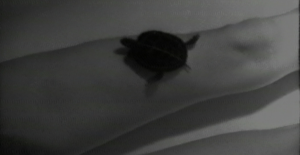
The domestic was redefined as an art space. The apartments I lived in, being very peripatetic as many were in that era, became the studio, and I was very adamant about that. They become the backdrop for all my production. At the time I referred to this work as “top of the table, under the table” pieces. I think I meant that there were different levels of control at work. For instance, in Know Your Turtle (22 minutes 1972), I was exploring the idea of how knowledge is transmitted, but I added the element of chance. A camera person moved between three rooms of a Toronto apartment. There was a sound recordist in the fourth room who took a live feed from all three rooms and mixed them independently from where the camera was. He didn’t know where the camera was. We’ve got one audio track, mixed from three different sources, while the camera physically moves from room to room. In the first room a young woman does a flat reading of an instructional manual about raising domestic turtles. Next door I’m running a bath, using a thermometer to set the temperature. There are two aquariums in the third room, each containing a swimming turtle. The only thing I had control over were my own actions. That was an important aspect. The reader says you need to contact your local wildlife federation if you’re going to go capturing turtles in the wild. Meanwhile I’m in the bathtub with the big turtle. And I’ve transferred a small turtle into the big turtle’s tank, and the big turtle is heading towards what looks to me like a forest under water. It’s the only moment of excitement in the 22 minute work.
Mike: There is a certain style that marks this period of video making – and I’m wondering if you could break that out for me a little bit. Early video cameras delivered hazy black and white pictures with mono sound, and editing was difficult. Artists made a virtue of these restrictions, can you talk about that?
Lisa: Performance for the camera was the obvious stylistic signature of this era, when you look back, in fact, someone like David Askevold’s work seems so out of time because he rarely did that. Mostly people turned the camera on themselves or their nearest and dearest. The video camera/monitor is a mirror, there is an instant feedback loop that was part of its profile, you can’t ignore that, and mostly we didn’t ignore it, we got right into it. This is a very different experience for someone who had come from film like I had. You shoot the film, you wind it up, you take it to the lab, you get it back and put it on the projector. It was a very long procedure. Video had none of that, you could be in this loop for better or worse, this loop of narcissism, of solipsistic reflection, or lack of reflection, and engagement with oneself. It wasn’t easy to edit, so many made direct documents. That’s how William Wegman worked, he turned the camera on, got his dog to do something, then turned the camera off when the action was finished. Many of my early tapes are like that.
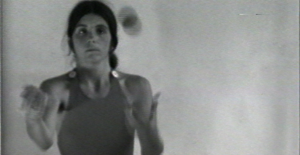
Mike: In Juggling (6 minutes 1972), your first movie, and one made in a single take, you show off your amateur juggling abilities and inabilities, often dropping the balls and moving out of frame, and then setting back up again. What is usually modeled at the front of the room, or in movies and public displays, are demonstrations of power, strength and wisdom. This movie suggests that the other side needs some airtime. That our leaders, or our attention, might be more usefully brought to those areas of our lives where we are not quite so perfect.
Lisa: The performance for camera work in my first videotape lasted until 1976 when I began to create scripted narratives. All of these early works are trying to discover, or maybe to reveal, how we come to know something, how we come to acquire knowledge of something, be it an activity — in the first tape it was juggling — or an object or a person or ourselves. I had been out of school for a few years and begun to take up my own studies. When I was at the Canadian Whole Earth Almanac I’d studied Wilhelm Reich, for instance, and that had led me to Freud. My adult life is a life of study and learning, and I had just begun that project.
In Juggling I’m practicing juggling on camera, and I’m not very good at it. The viewer does see me make a little bit of progress, at 3:15 I actually hold onto it for a little while, before it gets away from me again. I think this is a common experience when acquiring a technical skill. You get a little better, and then you plateau, and then you usually fall back. That’s my story. In other works from this time period I use improvisation to inquire into the nature of learning. How do we acquire knowledge? Most of the texts I was using in early video work like Internal Pornography (30 minutes, 3-monitor installation) were how-to manuals. Internal Pornography combines chance with simultaneity. The three channels were recorded separately, the length was determined by the length of the reel to reel tape, which was not an uncommon practice in this era. I shot on successive days, so what you see on three separate monitors was not planned moment to moment, frame by frame. You set up a structure and pour the content into it and see what happens. I liked the idea of not being completely in control of the work as it rolled out. The left channel sees me lying in my bed relating dreams, the middle channel shows a number of plants that I’d grown in my apartment, and the right channel offers me standing in front of a map of the world reading from a drug store manual for teenage girls called Once A Month The Egg Travels.
Mike: You were very prolific in this early period, and made many kinds of things, but some of the strongest work for me is very personal. In what used to be called experimental film, these first-person movies often took shape as lyrical diaries, largely silent, or at least unworded. They were montage based, and invited the viewers to see for themselves. In video, on the other hand, this same impulse appears as edit-free talkathons.
In Birthday Suit – with scars and defects (13 minutes 1974) you say, “In honour of my birthday I’m going to show you my birthday suit with scars and defects.” And then circling a barely discernible mark on your neck you announce, “1947, surgery at birth to remove goiter.” You take us on a chronological travelogue of your life via accidents and illness, pausing at each scar to rub the evidence like a Genie’s lamp, as if the memory will come back in its fullest form if only you ask persistently enough. What you are touching seems both mark and memory, as if the body holds and becomes memory. Is it too much to say that you show how the body is a field for receiving and holding memories, the memories of parent’s genetics on the inside, and our scarring encounters on the outside? Nature and nurture. Why did you want to make this work in particular? It seems unnaturally perfect. Was it important this movie be crafted out of the material of your body, of course it couldn’t be done in any other way, but the fact that your body appears as a material, was that important for you?
This movie became a kind of hit, an iconic work, in the years since it was released. Is it strange to have made such a large body of work, and then to have this one, in particular, singled out for attention? Is it like having a favoured child in the family? Does it overshadow other things you’re trying to say or show?
Lisa: This tape takes a much more straight forward approach to knowledge acquisition, this time concentrating on the memory of the body itself. The scars are catalogued as a series of actions, mostly accidents and mishaps, that have left a mark on me. I was remembering very vividly while making the tape, that was the purpose of the piece, to remember what had happened to my body. It’s a modeling and demonstration of the imperfect body, the feminist body. I used my nude body a lot in photography and video. I was challenging the viewer to look beyond the body itself, which is a shield. If you’re a young woman, this shield can be read as one of many images of nude young women that were proliferating throughout the media landscape as soft-core porn hit the newsstands in the 1970s. For a young woman artist the question became: How do you use your body? How do you make it more complicated and at the same time allow it to speak its own language?
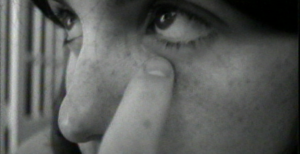
Birthday Suit offered a feminist critique of the airbrushed perfection of soft core porn. This is a context that is impossible to recreate. You cannot bring yourself back to the moment in the early 1970s when softcore porn went beyond Playboy and Moses Znaimer put Baby Blue movies up on late night TV. These days young women live their entire lives in a mediascape permeated with explicit sexuality, but ours didn’t. We transitioned from the repression of the 50s, to the Playboy bunny, to the steady escalation of porn in the public sphere. That transition happened while we were of an age to be in those pictures, except we weren’t those pictures. I’m not prudish, I’m open about sexuality, but there was a strong critique in this work about young women. Because all young women everywhere are subject to being looked at in a particular way. It doesn’t even matter what you look like. I wasn’t a bombshell, but you go out on the street and you’re looked at in a certain way and it makes you sick. You’re sick of the attention. You want the attention but you can’t stand it. Feminism was giving you a new language to be critical of it, and once you started being critical, you saw it everywhere. You become a fanatic. You’re in two places at once: in the experience and its critical overlay. And you’re thinking about alternatives. That sounds like there’s a plan but there wasn’t a plan, only experiments. Birthday Suit features an image of a naked young woman but she is controlling that image through her actions, and humour, and the fact that it reveals so-called imperfections like freckles and hair, in addition to scars. The last scar is on the underside of my breast, and has a narrativity now that I’m a breast cancer survivor. The tape doesn’t end there though, it ends with me singing happy birthday to myself and putting on my favourite bowling shirt.
I had written the dates down because I wanted to keep it in chronological order, that was the only script I had. I had built up to wanting to do it. I can’t imagine how I was so prescient to make it on my birthday. That’s a great gimmick. I’d already made a bunch of things before this, but this work was mine in a very different way.
Mike: A Very Personal Story (19:50 minutes 1974) is another single shot memory work, recounting a day when you are fifteen years old. You return home from school to find the door of your house open, snow drifts accumulating in the entrance way. Your two dogs are waiting at the foot of the couch where your mother lies dead. You recount the story in a curiously disaffected voice, even as you insist that this event marks some boundary line between the person you used to be, and the person whom no one else will ever know. “Probably my friends for the rest of my life would never understand what I understood right then.” What did you understand? And does it have something to do with this beautiful and unusual statement: “I felt more like myself then, than I’d ever felt before.” What does that mean?
Lisa: Don’t you feel that she (the speaker) sounds younger than she really is? As if the entire body is remembering. That’s what always strikes me. I had gradually lost most of my Midwestern accent by 1974, but I can hear it much more in this tape. In Birthday Suit and Personal Story I revert to a style of speaking that I wouldn’t have used in everyday life to talk to people I knew. The tape is made in “real time,” there is a simple recording of that period of time, and that may have agreed with something that I was interested in then. Is it not through the passage of time that we learn and acquire knowledge? There’s no Eureka moments, there’s just time. I’ve always felt it was hard to learn things, to be able to make a connection in your mind between two pieces of knowledge that would create a third. Because I was so untrained in that way, I felt I could never do those kinds of things. Maybe I’m dyslexic, or have a slight learning disability that nobody ever figured out. I always felt quick but not necessarily smart, even though I did well at school. That’s what I was always fighting against. That’s why my time-based work in this moment featured readings of entire books. I would walk around and do something and the recording would last as long as the demonstration. It’s kind of dumb way to approach a subject, especially when you have something as momentous as the day you discover your mother dead. But it’s very much like the earliest work I did where I read and performed actions.
I knew I would tell the end of the story, that my mother had died, and then I would start at the beginning of the day and see how much I could remember. I had never told the story before, there would be no reason to. I didn’t have any good friends. I’m so glad I made the tape because then I’d never have to say it again. The tape has a function in that sense. I’m being facetious here. I obviously wanted to tell the story.
I was reading Proust at this point, and working with the idea of body memory and unconscious memory. There are things you can’t recall until something happens to your body, and it’s stored somewhere there and then you can find it. A Personal Story stalled at the beginning. I would sit there with the camera rolling and I didn’t know how to start. I finally got it when I put my hands in front of my face, that was the breakthrough. I might have got the first sentence, I think I always knew I was going to say, “This is about the day my mother died.” And then I would start at the beginning of the day and see how much I could remember. I had never told the story before, there would be no reason to. I didn’t have any good friends. I’m so glad I made the tape because then I’d never have to say it again. The tape has a function in that sense. I’m being facetious here. I obviously wanted to tell the story. This tape and Birthday Suit are forms of self hypnosis.
Mike: You say in the tape that afternoon marked a line that will separate you even from your friends to come, even in the years ahead. As if no one will be able to understand what you’re saying. Video as friend, as electronic confessional, as pen pal, as container of private memory. The actions you describe, sitting quietly by the body, fetching a mirror to see if your mother’s still breathing, to confirm that she’s already dead, it all sounds so controlled and contained. So very grown up for a child of fifteen.
Lisa: In Internal Pornography I say, “If you really knew what was going on inside me, you wouldn’t want to know me.” I remember one of my friends at the time saying, “Well, that’s true of everybody, isn’t it?”
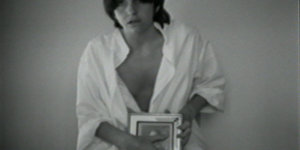
Mike: The Ballad of Dan Peoples (8 minutes 1976) is a performance piece for camera where you adopt the southern speed drawl of your grandfather in a repetitive incantation. Language, so often the sign of our easy communion, appears here as something very private, it’s hard to know what you’re saying at first. But slowly, as you repeat and interpolate phrases like the shifting pattern music of Steve Reich, it becomes clear that you are speaking in his voice of a moment when he is seventeen years old and raises a stick against his father, a larger than life man who had 22 children and three wives. Your grandfather is tired of being beaten by this man, and confronts this relentless bully of a father, and leaves home. It is a moment of independence, of breaking away from his family. It’s curious, that in this family story, you should focus on the way your grandfather breaks away from his family.
Lisa: I had seen my grandfather on the last day of his life, driving through Kansas City on the way to California. He was in a rest home and passed away the day after I saw him.
Mike: Did he recognize you?
Lisa: I can’t say he did. But knowing that he died within a few hours of seeing me, I suspect he processed it in some way. I had seen him the year before in the same nursing home – a country home for the elderly and the developmentally challenged – and that’s where the story of the mules comes from. (Towards the end of The Ballad of Dan Peoples Steele offer what seems a non-sequitur, “…down that corridor, they had the most beautiful mules that you ever saw.”) A young orderly overheard us talking when my grandad mentioned “beautiful mules” and he told us that this place used to be a stable for the Jackson County workers who looked after the roads. My grandfather remembered the mules. So that’s where that line comes from. I was so taken with the fact that he did remember, he was just seeing it as the present. So of course this moment was retrieved in the memory work I was doing in the video.
He had a beautiful speaking voice. He was a great joke teller and storyteller and I felt bad for not having recorded him. After news of his death I thought I would perform him, I’ll become my grandfather and tell some of his great stories. I sat down in front of the camera day after day and couldn’t remember a single one. That’s when I put the oversized white shirt on. I don’t think I’ve ever said it’s his shirt, people say it’s his shirt and I’ve never corrected it. But I could correct it now. It wasn’t his shirt, he was smaller than I am, he was a tiny man. This was not his shirt, but I did hold a picture of him as a young man. I had been thinking for a couple of days that maybe I would sing. That’s where the title and the delivery come from. I got the first line and that helped me. “I come up over the hill and I seen him, I seen him standin’ there, ‘bout half a mile down the road.” I didn’t know what it meant. When it was done I turned off the camera and then I didn’t look at it for maybe a couple of weeks. Then my brother came to see me in Los Angeles where I was living. He and I sat down and looked at it together and were totally shocked. The story I tell in looping fragments is that my grandfather was beaten as a kid by his father and one day he stands up to him and leaves home. My brother said, “There’s the one about the guy and the vacuum cleaner, and the one about peeing through the keyhole…” We both remembered the funny stories, but what struck me when the camera was turned on was the violence. The kids forced to look on as the preacher came and ate all of their eggs.
Mike: These memory pieces were part of a deluge of new makings while you were in California with Colin Campbell.
Lisa: In 1975, Colin Campbell and I were together and we started collaborating and appearing in each other’s work, which was really fun. It was a whole year of dress-up and crazy stuff and we made a lot of really good work: his Woman from Malibu Series (1976-77), while I did The Scientist Tapes (69 minutes, 1977-78), and Waiting for Lancelot (79 minutes, 1976). I had started to write a lot more, so these were scripted works. We did a lot of that when we were in California.
The Scientist Tapes and Waiting were the beginnings of trying to find a different way to create character, two different sets of experiments. Waiting for Lancelot is an extended poetic exploration of relationships, desire and visions. I was attempting to write a much meatier piece of work and I could only do that using voice-over. I was very careful with the camera set-ups, everything was framed perfectly to catch the light. Finally I felt Lancelot had created prototypes or archetypes but not characters.
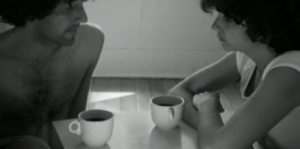
The Scientist Tapes was taken almost totally out of the newspapers and explored the difference between person and persona. My most Bresson-influenced work. It’s a two-hander written for Colin and I, in four acts. We both play scientists — a genetic engineer and a clinical microbiologist — who are having a long distance love affair.
I returned to Toronto and went back to work at Interval House in 1977. (I had worked there from 1974 until leaving for California in 1976.) It was the first shelter for battered women in North America, and modeled after the British system. Nobody was a professional counselor, the hope was to simply keep the place open, have a safe place for women with children, and try to help them find their way through the system which nobody knew anything about. It’s become increasingly professionalized, but in the seventies we were hired as counselors, not social workers. If we needed social workers we would go and get them to help our clients, who we didn’t call our clients, we called them “the women.” Women who experienced violence were called “runaway wives” by the newspapers. Our first public job was to change the language and that took a long time.
There was someone on duty twenty four hours a day. You did at least one overnight shift a week, and usually three other eight hour shifts, day or evening. You lived with them and got to know them very well. A woman might stay a very short period of time and return to her circumstances within a week or two after counseling or because of family pressures, and sometimes things worked out. Some shelters said that a woman couldn’t come back but we never did. We always tried to make sure that the women weren’t feeling pressure and knew they could stay if they wanted. People might stay a day, two days, two weeks, or longer. Six to eight weeks wouldn’t be unusual, particularly if they had a difficult situation. There might be language issues, super violence, fear, children with disabilities, charges in the criminal court, everything starts to add up.
Mike: Was it a hard job?
Lisa: I don’t ever recall feeling like it was a hard job. It was tiring sometimes but for the first time in my life I felt competent. I could go to the supermarket and buy seven buggies full of groceries. I helped start the fundraising team. I managed a big renovation project where we put in a new kitchen and raised all the money for it. I liked doing court support, going to court with women. I could negotiate with the cops. It really added to my sense of empowerment, being an artist hadn’t particularly done that for me. I worked there for a couple of years, and then I went to California with Colin and made a lot of work. I came back to Interval House after being away for a year and immediately saw that the people I was working with would become my new characters. I had been in this artist bubble. While in California I had a Canada Council grant, which was the most fabulous thing because I actually did not work for the first time in my life since I was fourteen. In eight or nine months, I produced thirteen works and came back to Toronto as broke as anything imaginable. I went right back to the work and I immediately thought, “OK. That’s over. I’m doing something else now.” I started the videos Makin’ Strange (16 minutes 1978) and The Damages (18 minutes 1978) right away, within a few months of each other. They were really a break for me, because I started to create this one character and then I did a live performance of her.
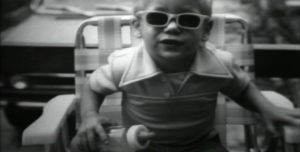
Feminism influenced this work because I really took on the idea that I was working with these women. What I wanted to do was to understand some of the women who would come into Interval House. One would think: “This person might never survive. How can they negotiate anything, let alone welfare and public housing, and getting their kids enrolled in school?” Due to abuse or bad planning, these Canadian women were so economically disadvantaged that they found themselves in front of these big machines that they had to maneuver within: social services, Children’s Aid, the courts. I made this work in order to try to understand how they could come out of their often dire situations and actually make some progress with their lives. In order to understand, I had to create these characters.
We had to do overnight shifts at Interval House, and one of the late night conversations was about the different characters that the women who were at the house at the time liked on the soap opera The Young and the Restless. Someone said, “I like the way they look and stuff, but why don’t they ever make a soap opera about people who are not so rich?” That’s where the format for The Gloria Tapes came from.
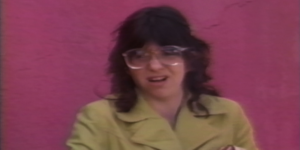
Mike: The Gloria Tapes (55 minutes 1980) features yourself in the title role as Gloria Pauly, taking a star turn in scene after scene with non-stop, welfare mom chatter. I think it’s a remarkable thing, one of the signal events in Canadian video art. In your first colour movie, a talkie delivered almost exclusively in master shots, Gloria is caught in a circle of institutions that are at once helpful and threatening: hospitals, social agencies, welfare. Derelict boyfriend Billy uses a condom twice which leads to another unwanted pregnancy, shopping asides become money meditations, social worker exchanges allow her to speak about incest for the first time, a subject she brings up with her sister just before they meet up with a judge. Will she keep her baby or will social services take him away? The tape delivers in a pitch that is one jot removed from melodrama on one side and irony on the other. It features a kind of kitchen-sink realism, never mind that it is stuffed with a supporting cast drawn from fellow Queen Street hipsters and Interval House co-workers, all looking skinny and suave.
Lisa: It was certainly influenced by Mary Hartman, Mary Hartman, Colin and I were watching that in California. The characters were composites of people I met. I would take situations and lines from real life, and make them into stories. Gloria is a composite of all of those young women who seemed so hopeless when they came in that you can’t imagine how they’re going to make it. But unless they had mental illness, they would often overcome extraordinary situations, in ways that were surprising. I felt a great deal of empathy because of what I’d mentioned before, that I was no expert in anything. I wasn’t just mimicking or pretending to be somebody, I felt quite close to these women. All that separated us was a different set of privileges or opportunities or accidents that were on the good side rather than the bad.
Every scene was made in a single master shot. We would shoot over a period of time, let’s see, you’d have to put the wallpaper up, and there were a lot of props and people. I think that each of the individual scenes were probably shot in a day. It would depend on my work schedule and other people’s schedules. It was mostly shot by Clive Robertson, there was no lighting person or sound recordist. Every time you made an edit you would cut into the previous scene. I can remember maybe once or twice where we started a scene and had to stop. That’s why at the end of a scene the camera might linger on the crib or the tires for a while, because you have to have something to cut into in case you flub a line. It’s all crash editing, working in sequential order.
I’d do all the prep work and get my costume on and the glasses and get into character and run people’s lines while the camera was getting set up. Everybody said the lines as they were written, people were pretty good about it. I would adlib mine mostly, I would kind of know what I was going to say, but not exactly, I would give myself leeway. Robert Stewart was great as the boyfriend, you know who he is, right? He was part of the band The Government with Andy Paterson. Kenneth Coutts-Smith was a Marxist art historian who was part of Fuse Magazine, he plays my father. Some of the women I worked with play the social worker and the doctor.
It started out with Gloria becoming pregnant and I was interested to see where it could go. I wanted to touch on the controversial issue of sexual abuse in the family that was just beginning to be spoken about. The scene I can remember taking a lot of time was the one where Gloria’s on the phone. The camera pans down and you see she’s in a room full of tires. She’s talking to her girlfriend about her boyfriend’s stolen goods, and how he didn’t boost perfume and TVs, only tires and car parts. She has to leave the apartment before the police come. Gloria was someone who could work through all these problems, I think that’s why the work was well received, there was nothing else quite like it. There were other video art narratives, but nothing that allowed you to follow characters into another world.